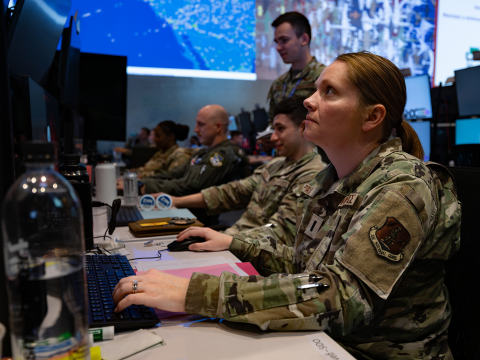Military Leaders Tackle Tough Issues
Military leaders gathered yesterday at the TechNet Land Forces conference in Tucson, Arizona, for a blunt discussion of technology challenges facing current and future forces.
Mike Krieger, deputy chief information officer for the U.S. Army, updated attendees on the progress transitioning to Army Enterprise Email services provided by the Defense Information Systems Agency (DISA). That migration is scheduled for completion in March 2013, but Krieger is already looking ahead.
“The next service we’re trying to migrate to DISA is Enterprise Collaboration Service,” Krieger revealed. “This is really about being able to do two things. I can get to my email without a [virtual private network] from a private computer, a public computer, a military computer and a $10 CAC [common access card] reader. So, with Enterprise Collaboration Service, you take it a step further. Now I’ve got my private files, my public files, collaboration in the DISA-provided cloud, and I’ll be able to get to that data with a private computer, public computer or $10 CAC reader and not have a virtual private network. It will eliminate the O drive, the H drive, and the D drive and put the data into the DoD [joint] cloud,” he said.
Krieger went on to say that there really is not a Global Information Grid (GIG). “Although DOD always talks about the GIG, there really isn’t one. There’s a bunch of private, wired networks hiding behind racks of equipment. Army’s got one, Navy’s got one, Marine Corps has got one, DISA’s got one, DLA’s [Defense Logistics Agency’s] got one, NSA’s [National Security Agency’s] got one. I really don’t think that’s the right way to do business. It’s harder to secure it. It’s more expensive. And it’s harder to share,” he said.
Col. Paul Miller, USMC, assistant chief of staff, G6, I Marine Expeditionary Force, transitioned the discussion from the chief information officer level to the tactical level with a discussion of issues affecting warfighters with boots on the ground in the combat zone. Col. Miller outlined issues facing the Marine Corps, which has fewer resources than the other services and a need to be interoperable with both the Navy and the Army.
“The Marine Corps gets put in an odd position. We have to be interoperable with the Navy on the ship, but when we get to shore working with the Army, and we obviously have to be interoperable with them,” Krieger said, conceding that the problem is nothing new.
Serving as luncheon keynote speaker, Brig. Gen. Frederick Henry, USA, deputy commanding general of the Army’s Network Enterprise Technology Command, offered a thorough briefing on the Army Baseline Information Technology Services (ABITS) strategy for service management. He described ABITS as an adoption of best practices. “Those best practices have to be standardized where applicable. We have to normalize what it is we want to deliver and achieve so that NETCOM can have a better appreciation for the cost. Because if you have too much variance in your standards, it’s hard to control what you’re paying,” Gen. Henry said.




Comments